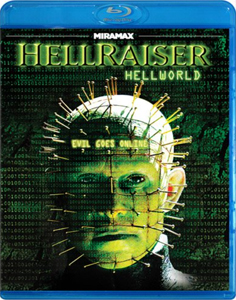“Hellraiser: Hellworld” (2005) – the saga’s eighth film, third in a row from director Rick Bota and second consecutive film shot in Romania – is so close to being a sharp meta sequel. But by leaving a major piece of the puzzle unexplained, it ends up frustratingly incomplete.
First, the good stuff. Bota knows his craft. He’s underrated by “Hellraiser” fans because he helms three films that use Pinhead (Doug Bradley), the Cenobites and the Puzzle Box as spices rather than the main course.
To people who come for that stuff, these straight-to-video films are disappointing. But for people who want to see solid psych-thrillers, they aren’t bad. He gets strong performances out of his casts, maximizes production value, paces the action with forward momentum (despite hazy mixes of the real and surreal in the scripts) and ultimately delivers strong pictures on the cheap.

“Hellraiser: Hellworld” (2005)
Director: Rick Bota
Writers: Carl V. Dupré (screenplay), Joel Soisson (story)
Stars: Lance Henriksen, Katheryn Winnick, Henry Cavill
A post-‘Scream’ sensibility
In “Hellworld,” Bota is gifted with horror legend Lance Henricksen, who can turn chickens*** into chicken salad with his deep voice, and he often does so here as The Host. Future Superman Henry Cavill is at the other end of the star-making timeline as one of a group of friends who attends The Host’s mansion party themed after “Hellworld,” a game based on the “Hellraiser” myth.
Also in the group: Katheryn Winnick is a strong Final Girl, Christopher Jacot shows why he has continued to get work in Canadian horror, and I also quite like Anna Tolputt as the cute British-accented member of the gamer group.
Bota purposely makes the first “Scream”-styled “Hellraiser” film, with that meta premise – provided by short story writer Joel Soisson and screenwriter Carl V. Depre (“Inferno”) – and jump scares that turn out to be nothing, leading us to giggle in relief. “Saw” and haunted-house stylings later join the slasher trappings.
As is always the case in “Hellraiser” films, what we see is a mix of reality and nightmare imagery that exists only in the characters’ minds. In the end, we learn the reason for everyone’s false images, and it’s not the usual answer. Does the film play fair in this regard? Ultimately, I think it does, barely.
I’ll discuss that – as well as the aforementioned missing puzzle piece – after this SPOILER WARNING.
The missing puzzle piece (Spoilers)
First, the false images. They are created not by Pinhead but rather by The Host, who has actually drugged and buried (with air tubes) the main partiers. They were friends of his late son, Adam. They all played “Hellworld” and Adam got addicted to the game and killed himself; The Host blames the friends and wants revenge.

The Host’s ability to manipulate the drugged partiers so specifically is a stretch, as is the fact that he buries them in the yard while the party is going on, without assistants. But ultimately I decided to let it slide. Because I have a much bigger problem with this film.
Off screen, somebody learned about the entire “Hellraiser” mythology – Pinhead, the Cenobites, the Puzzle Boxes, the Lament Configuration and the LeMarchand family – and made an online interactive video game about it.
The secrecy of the mythology – the fact that in every film someone comes upon the Puzzle Box and doesn’t know what it is – is central to the first seven films. The worst one, “Bloodline,” almost offends this sensibility, but one can surmise that the LeMarchand descendant knows a little something via stories passed down through the generations.
How it could’ve been fixed (Spoilers)
In “Hellworld,” the nature of Hell is inexplicably known by an off-screen game designer, who copies it precisely for a game. The way this person learns the mythology without getting burned by it should be a movie on its own, or at least a robust prolog.
Dupre possibly could’ve tied things together by having The Host be the game designer. But he’s not; he’s just a vengeful father who is particularly good at using his voice to manipulate people on hallucinogenic drugs.
Another way “Hellworld” could’ve clicked – and even approached brilliance — is if it had used the trick later employed by “Amityville: The Awakening” (2017). Have the film take place in a “real world” where the partiers are big fans of the first seven “Hellraiser” films.
END OF SPOILERS.
While “Hellraiser: Hellworld” is as well-directed as Bota’s previous entries – albeit slicker and more mainstream with the post-“Scream” stylings – the frustrating fact that the story has a huge logic hole means I can’t rate it highly.
I’m not wedded to the idea that “Hellraiser” films must robustly feature Pinhead and company. But I do believe that if you alter the established lore, you must explain it in the film’s text, rather than having a massive development happen off screen.

